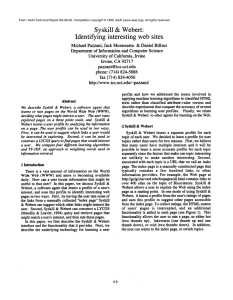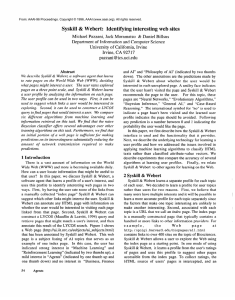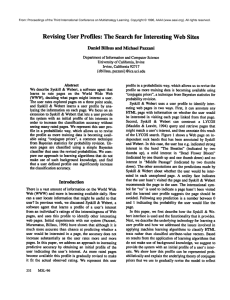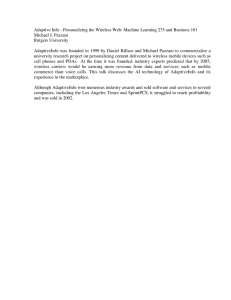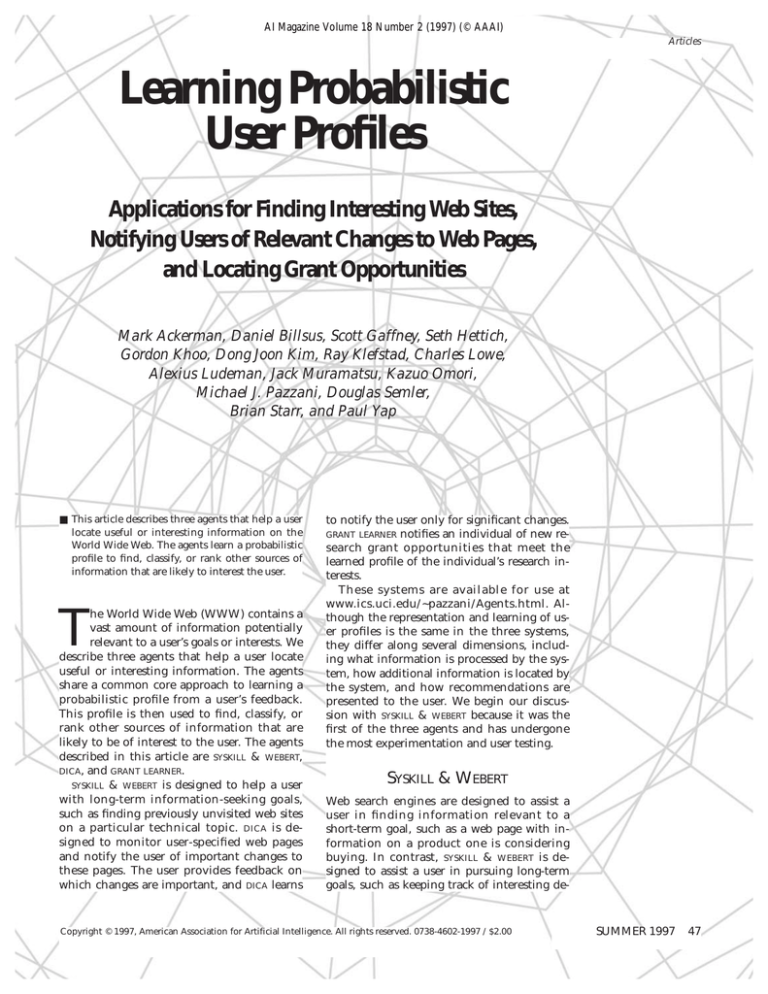
AI Magazine Volume 18 Number 2 (1997) (© AAAI)
Articles
Learning Probabilistic
User Profiles
Applications for Finding Interesting Web Sites,
Notifying Users of Relevant Changes to Web Pages,
and Locating Grant Opportunities
Mark Ackerman, Daniel Billsus, Scott Gaffney, Seth Hettich,
Gordon Khoo, Dong Joon Kim, Ray Klefstad, Charles Lowe,
Alexius Ludeman, Jack Muramatsu, Kazuo Omori,
Michael J. Pazzani, Douglas Semler,
Brian Starr, and Paul Yap
■ This article describes three agents that help a user
locate useful or interesting information on the
World Wide Web. The agents learn a probabilistic
profile to find, classify, or rank other sources of
information that are likely to interest the user.
T
he World Wide Web (WWW) contains a
vast amount of information potentially
relevant to a user’s goals or interests. We
describe three agents that help a user locate
useful or interesting information. The agents
share a common core approach to learning a
probabilistic profile from a user’s feedback.
This profile is then used to find, classify, or
rank other sources of information that are
likely to be of interest to the user. The agents
described in this article are SYSKILL & WEBERT,
DICA, and GRANT LEARNER.
SYSKILL & WEBERT is designed to help a user
with long-term information-seeking goals,
such as finding previously unvisited web sites
on a particular technical topic. DICA is designed to monitor user-specified web pages
and notify the user of important changes to
these pages. The user provides feedback on
which changes are important, and DICA learns
to notify the user only for significant changes.
GRANT LEARNER notifies an individual of new research grant opportunities that meet the
learned profile of the individual’s research interests.
These systems are available for use at
www.ics.uci.edu/~pazzani/Agents.html. Although the representation and learning of user profiles is the same in the three systems,
they differ along several dimensions, including what information is processed by the system, how additional information is located by
the system, and how recommendations are
presented to the user. We begin our discussion with SYSKILL & WEBERT because it was the
first of the three agents and has undergone
the most experimentation and user testing.
SYSKILL & WEBERT
Web search engines are designed to assist a
user in finding information relevant to a
short-term goal, such as a web page with information on a product one is considering
buying. In contrast, SYSKILL & WEBERT is designed to assist a user in pursuing long-term
goals, such as keeping track of interesting de-
Copyright © 1997, American Association for Artificial Intelligence. All rights reserved. 0738-4602-1997 / $2.00
SUMMER 1997
47
Articles
Figure 1. The SYSKILL & WEBERT Interface for Rating Web Pages Adds Additional Commands to the Web Browser.
velopments or information resources in a particular field. The current version of SYSKILL &
WEBERT is implemented as a plug-in and collection of JAVA classes that add extra functions
to a web browser. A user of SYSKILL & WEBERT
first declares a new topic (or reuses an existing topic). Topics of current users include
biomedical computing, independent recording artists, and raising goats. The user can optionally associate with each topic one or
more topic pages, which are typically pages
created by a person listing web pages available on the topic. For example, golgli.harvard.edu/biopages/all.html contains links to
more than 2000 web pages on biosciences. Although the maintainers of this page have
done a remarkable job of collecting information, the usefulness of the resource would be
enhanced if there were an assistant watching
the user explore this resource, learning
his/her interests, and recommending which
unvisited links should be explored next.
SYSKILL & WEBERT is designed to provide such
assistance.
48
AI MAGAZINE
Rather than inferring the user’s preferences
from behavior (Lieberman 1995), SYSKILL &
WEBERT allows the user to provide feedback on
the interestingness or usefulness of a web
page. The user can click on hot or cold buttons that are added to the browser window
(figure 1).1 SYSKILL & WEBERT records these ratings to learn a profile of the user’s likes and
dislikes. A simple Bayesian (Duda and Hart
1973) classifier creates a user profile from the
user’s preferences. The profile can be used to
calculate the probability that any web page is
interesting to the user. SYSKILL & WEBERT can
locate potentially interesting pages in two
ways: First, it can locate pages directly accessible from the current page. Second, it can construct a query of a search engine such as LYCOS
(Mauldin and Leavitt 1994). Two types of
word are used to build a query: First, a query
contains words that occur in the most number of pages that have been rated hot (ignoring common English words and all hypertext
markup language [HTML] commands). Second, a query contains words whose presence
Articles
Figure 2. An Example of a Page Annotated by SYSKILL & WEBERT.
Here, SYSKILL & WEBERT constructed a LYCOS query from a user profile for the biomedical topic.
in an HTML file helps discriminate pages that
are rated hot from cold using mutual information. Because LYCOS cannot accept long
queries, we use the seven most informative
words that are found in a higher proportion
of hot pages than all pages and the seven
most commonly occurring words as a query.
Once a search engine returns a page with
links to potentially relevant pages, SYSKILL &
WEBERT retrieves each page and analyzes the
HTML to produce its recommendations. Although this process is time consuming,2 the
page ratings of SYSKILL & WEBERT can reduce
the time spent by a user manually searching
SUMMER 1997 49
Articles
90
80
70
Accuracy
60
Movies
50
0
10
20
30
40
Number of Examples
50
Figure 3. SYSKILL & WEBERT’s Accuracy at Predicting the User’s Preference
for Movies Increases to More Than 80 Percent.
the web. In the newest version of SYSKILL & WEBERT, the multithreading capabilities of JAVA are
exploited so that page ratings are displayed
interactively while other pages are being retrieved.
SYSKILL & WEBERT displays its recommendations by annotating links that point to web
pages that have been rated. Figure 2 shows an
example of a web page returned by LYCOS using a query constructed by SYSKILL & WEBERT.
The annotations indicate whether the user is
likely to be interested in the page and what
the probability is that a page is interesting.
Pazzani, Muramatsu, and Billsus (1996) provide details on how SYSKILL & WEBERT learns
and uses a profile. Here, we just summarize
the most important details. SYSKILL & WEBERT
represents each page rated by the user as a set
of Boolean features. Each feature corresponds
to the presence or absence of a particular
word. SYSKILL & WEBERT selects the 96 most informative (Lewis 1992; Quinlan 1986) words3
as features (that is, words that occur in a
greater proportion of hot training documents
than cold, or vice versa). Once represented as
a set of Boolean features, a variety of machine-learning or information-filtering algorithms might be used to create a user profile.
50
AI MAGAZINE
The publicly available version of SYSKILL & WEBERT uses a standard machine-learning algorithm, a Bayesian classifier to create a probabilistic profile. The profile contains the
estimated prior probability that a page is hot
(and cold) and, for each informative feature,
the conditional probability that a page contains (and doesn’t contain) a word given that
the page is hot (and cold). This algorithm was
selected because it was experimentally found
to be one of the most accurate at this task, it
has desirable time and space complexity (linear in the number of examples and features),
and it estimates the probability that a page
would be interesting to the user for a particular topic. This probability can be used to rank
the unseen pages. The probability can also be
used to decide whether to recommend the
page to the user. By selecting a threshold for
the probability, it is possible to trade precision for recall. We use 0.5 as the default
threshold in SYSKILL & WEBERT.
We have run several experiments to evaluate how often SYSKILL & WEBERT’s prediction
agrees with the user’s rating of a page. Here,
we report on one such experiment that was
conducted using 48 web pages rated by a user
on the topic of films that were available at
Articles
Combination of Five Topics
71
70
69
Accuracy
68
67
0
100
200
300
Number of Examples
400
Figure 4. The Bias of the Bayesian Classifier Is Not Suitable for
Representing a User Profile When There Are Several Different
Types of Page That Are Liked by the User.
rte66.com/Movies/blurb.html. In this case,
the user rated the pages according to whether
the user liked the film that was described by
the page. Each page had information on the
people involved with the film and a summary
of the film. Twenty-five of the 48 pages were
rated hot by the user. To test the ability of
SYSKILL & WEBERT to learn the user’s preferences, it was trained on a subset of the rated
pages and evaluated on pages that were not
in the training set. Because we are interested
in seeing how many pages a user would have
to rate to learn a useful profile, we increased
the number of training pages from 10 to 35
in increments of 5. Figure 3 shows the average accuracy at predicting unseen pages as a
function of the number of training examples.
Each point represents the average of 40 trials.
On each trial, n pages were randomly selected
for training, and a new profile was learned for
these pages. The accuracy of the test consisting of all pages not in the training set was
computed. The figure shows that with 10 rated pages, SYSKILL & WEBERT performs at near
chance levels. However, as the number of rated pages increases, the accuracy of its predictions increases. When trained on 35 pages,
SYSKILL & WEBERT agreed with the user’s rating
more than 80 percent of the time.
The user profile provides relatively finegrained probability estimates that can also be
used to order the exploration of new pages.
For example, on the biomedical domain, we
used a leave-one-out testing methodology to
predict the probability that a user would be
interested in a page. The 10 pages with the
highest probability were all correctly classified as interesting, and the 10 pages with
the lowest probability were all correctly classified as uninteresting. There were 21 pages
whose probability of being interesting was
above 0.9, and 19 of these were rated as interesting by the user. Sixty-four pages had a
probability of being interesting that was below 0.1, and only 1 was rated as interesting
by the user.
The decision to learn a separate profile for
each topic in SYSKILL & WEBERT was based on
our intuition that restricting the scope would
simplify the learner’s task. In principle, an intelligent agent, such as a close colleague,
should be able to fairly accurately decide
whether any web page would interest a user
without regard to whether the topic is films
SUMMER 1997 51
Articles
In principle,
an intelligent
agent, such as
a close
colleague,
should be able
to fairly
accurately
decide
whether any
web page
would interest
a user
without
regard to
whether the
topic is films
or biomedical
research.
or biomedical research. The experiment we
report next investigated whether SYSKILL & WEBERT would be able to accurately learn a user’s
preferences when data from several topics are
combined. In particular, we pooled pages
from 5 topics rated by a single user and created a collection of more than 450 documents.
The user rated 69.5 percent of these documents as cold. The results of an experiment
on these data, run in the same manner as the
previous experiment, are reported in figure 4.
Here, we see that the Bayesian classifier does
not reach an accuracy level that differs substantially from simply guessing that the user
would not like any page.
The problem arises for two reasons: First,
words that are informative in one domain
(for example, recording artists) are irrelevant
in another (for example, biomedical applications). Furthermore, within a particular single
domain, it is possible that a simple decision
boundary exists that separates the interesting
pages from the others. However, it is likely
that in several domains, there are a variety of
complex clusters of interesting articles, and
the Bayesian classifier is unable to represent
this decision boundary. One might suspect
that a more complex learning algorithm
might perform better at this more general
problem. However, neither decision tree
learners nor multilayer neural nets were more
accurate than the Bayesian classifier because
of the relatively small number of examples
available for the complex high-dimensional
concept needed to make accurate predictions
across domains. Therefore, we conclude that
asking the user to provide a topic and learning a separate profile for each topic is an essential, and not particularly burdensome, requirement for an agent such as SYSKILL &
WEBERT.
In summary, SYSKILL & WEBERT collects a user’s ratings of web pages, learns a profile of
the user’s preferences for pages of a given topic, retrieves and rates unseen web pages, and
annotates links pointed to rated pages with a
rating of the page.
DICA
The DICA (do-I-care agent) (Starr, Ackerman,
and Pazzani 1996) Project explores a naturally
reoccurring problem with the web. Even after
one has discovered web resources, a problem
remains: How do you know when to revisit
these resources for new material? Consider
some common postdiscovery situations:
First, you know the page where a colleague
has his publications. You would like to obtain
52
AI MAGAZINE
new papers as they are posted. Furthermore,
you would like to know only about papers on
a particular topic rather than all papers.
Second, you have obtained the page for a
low-cost clothes merchandiser. You would
like to know when there is a sale on jeans or
Hawaiian shirts.
These are examples of change events that
occur somewhat unpredictably and offer no
explicit notification. Today, interested parties
must occasionally check by hand. This process can be burdensome and tedious, and one
might forget to do it on a timely basis. Furthermore, we would like an agent to notify us
only of changes that are significant. DICA creates and maintains a web page to report its
findings to a user. DICA agents of other users
can monitor such a web page to be notified
when another user’s agent has found an interesting change to the web.
DICA explores the nature of collaborative resource discovery and information sharing on
the web. Its goal is to augment certain types
of computer-supported cooperative work situations. Collaborative efforts to discover internet resources, such as interesting web pages,
require work by users. Unfortunately, users
often will not do the extra, altruistic work,
leading to adoption failures for social-filtering
systems. DICA assumes that agents are especially useful in situations where the benefits
would be marginal if the task had to be done
by hand and that cooperating agents are especially useful in situations where individuals
want to use the agents for their own purposes
anyway.
To track interesting changes, an agent
needs to know what changes are interesting
and where to find them. DICA collaborates
with both users and their peers to identify
potentially interesting changes. The agent
works by soliciting a user’s opinions about
changes it finds to train the user model; it is
in the users’ best interests to keep their personal agents informed about relevant pages
and the quality of reported changes. Without
extra work, the agent can then share these
opinions and findings with agents of likeminded users. Individuals engage in resource
discovery for themselves, but they can share
this effort without any extra work.
Because different changes can be interesting
for different reasons, users can maintain multiple DICA agents specialized on particular topics or kinds of web page. Each DICA agent must
periodically visit a user-defined list of target
pages, identify any changes since the last time
the agent visited, decide whether the changes
were interesting, notify the user if the change
Articles
Figure 5. The University of California at Irvine GRANT LEARNER Interface for Finding Grant Opportunities for Funded Research.
was interesting, accept relevance feedback
(Rocchio 1971) on the interestingness of the
change and the timeliness of the notification,
and facilitate information sharing and collaboration between individuals and groups.
DICA maintains a list of web pages for each
user’s topic that have interesting information.
By limiting the search to a small subset of
web pages specifically selected because they
are likely to contain interesting information,
we can greatly improve precision. By accepting or rejecting DICA’s suggestions, the user
refines the types of change that are interesting. Like SYSKILL & WEBERT, a Bayesian classifier
learns a profile. The primary difference to the
learning algorithm between SYSKILL & WEBERT
and DICA is that SYSKILL & WEBERT extracts features from a web page to determine the interestingness of the page, but DICA extracts features from the difference between the current
and an earlier version of a web page (computed using the UNIX diff command).
Once an agent spots an interesting change,
the user is notified by e-mail, and the change
is appended to the agent’s associated web
page. This web page is also used for relevance
feedback and collaborative activity. DICA addresses two post-discovery problems: (1)
when a user should revisit a known site for
new information and (2) how a user shares
new information with others who might be
interested. These post-discovery chores are laborious, suffer from inequitable distribution
of costs and benefits, and are not both addressed by existing systems. By providing a
simple technical mechanism, we have found
a collaboration mechanism that provides for
group effort through individual incentives.
GRANT LEARNER
The profiles learned by the Bayesian classifier
are in no way limited to web pages and can
SUMMER 1997 53
Articles
The Influence of Feature Selection
90
80
70
Accuracy
96 Informative Features
User Selected Features
Informative and Related
60
50
0
10
20
30
40
Number Of Examples
50
60
Figure 6. Improving on the Bayesian Classifier by
Automatically or Manually Selecting Relevant Features.
be applied to all kinds of text document
available on the internet. In a different project, we are using the described learning techniques to classify descriptions of funding opportunities. The goal of the University of
California at Irvine GRANT LEARNER Project is to
provide a system that learns to distinguish
between interesting and uninteresting funding opportunities based on a user’s ratings of
these descriptions.
Our current implementation of GRANT LEARNER is a JAVA stand-alone application that runs
on any JAVA-compatible platform. It connects
to a regularly updated grant database maintained at UCI and provides a user interface to
browse this database. Figure 5 shows a screen
shot of the current version of GRANT LEARNER.
The system displays a list of all grant subjects
available in the database. By clicking on a subject line, the user can retrieve a corresponding
full-text description. Grant descriptions usually provide information about the grant’s subject area, funds, eligibility, and deadlines. Using the hot and cold buttons, the user can
indicate whether a grant description is related
to his/her interests. Once the user has rated a
54
AI MAGAZINE
minimum number of grants (10 in the current
implementation), GRANT LEARNER uses the previously described feature-extraction and learning algorithms to learn a profile of the user’s
interests. The learned profile is then used to
process the rest of the database, that is, all the
grant descriptions remaining to be looked at
by the user. The result of this process is a list
of grant descriptions sorted according to
GRANT LEARNER’s relevance prediction. A learned
user profile can be saved and reused at a later
time. For example, users can train GRANT
LEARNER with a set of rated descriptions once
and reuse the learned classifier at a later time
to get a ranked list of database entries that
were added recently. First experiments and
feedback from different users suggest that
GRANT LEARNER is a helpful tool to locate potentially interesting grant descriptions.
Future versions of GRANT LEARNER will allow
the use of the same learned profile to filter
different grant databases (for example, IRIS
and the National Science Foundation grant
database). We are also planning to implement
an e-mail notification system, such that users
are automatically notified when a grant rele-
Articles
pygmy
milk
library
program
however
took
return
animal
breeding
computer
health
quality
production
angora
feeding
fair
dairy
early
cashmere
feed
cheese
fiber
time
normal
management
spring
other
green
summer
farm
Table 1. The Stricken Words Are Excluded as Features by Using WORDNET.
vant to their interests is added to a database.
In addition, we believe that exploiting the
structure of descriptions, for example, deadline or eligibility sections, is useful to construct a set of special-purpose features that
help prevent the system from suggesting
grants for which one is ineligible or whose
deadlines have passed. More information
about the UCI GRANT LEARNER can be found at
www.ics.uci.edu/~dbillsus/grantlearner.html.
Current Research Work
Our current research (for example, Billsus and
Pazzani [1996]) involves exploiting different
forms of knowledge or information to improve the accuracy of an agent’s recommendations. The goal is to reduce the overall effort required by a user to get useful results
from the agent. Our efforts have focused on
finding additional information to determine
which words should be features in the profile.
Although implemented in an experimental
version of SYSKILL & WEBERT, they are of more
general applicability. We have explored two
ways of addressing this problem:
First is asking the user for words to use as
features for each topic. SYSKILL & WEBERT can
take advantage of the user’s knowledge of the
domain to identify key terms.
Second is using additional lexical knowledge to filter the informative features. We
have experimented with using W O R D N E T
(Miller 1994), a lexical database containing
the relationships between approximately
30,000 commonly occurring English words.
When there is no relationship between a
word and the topic (for example, goat), SYSKILL
& WEBERT can eliminate the word from consideration as a feature.
Figure 6 shows an experiment (run in the
same manner as the previous experiments)
on the goat topic. The experiment uses
profiles learned by a Bayesian classifier in
which we compare the accuracy of representing documents by the 96 most informative
words, the words that a user indicates are
most useful in determining whether a page is
interesting, and the subset of the 96 most informative features that are related to the
word goat according to WORDNET (by following
a series of hypernym, antonym, memberholonym, or part-holonym links between the
word and the word goat). The results show
that both approaches to selecting features improve on the use of just the statistical information available in the training data. On this
problem, the user-selected features only provide a benefit when there are few training examples. Using the additional lexical knowledge encoded in WORDNET to only retain the
subset of the 96 informative features that are
related to the topic provides a substantial improvement in accuracy on this problem.
Table 1 lists some informative features
found from one training set and strikes out
those for which no relationship exists between the word and the topic. Although
there is room for improvement, WORDNET does
remove many words that are unrelated to the
topic (and a few, such as farm, that are related). Most of the words that are not eliminated are related to the topic (with a few exceptions, for example, computer).
Our future plans also include a significant
enhancement to the SYSKILL & WEBERT interface
that allows users to share their profiles with
other users. In many fields, communities of interest already exist; that is, people know who
else is working in their respective fields or who
is to be considered an expert in a certain area.
We envision a useful information-filtering
framework that allows people to publish their
specialized filtering profiles electronically.
SUMMER 1997 55
Articles
These profiles could then be used by other
people interested in someone’s area of expertise and be utilized as intelligent filtering tools
to view large information spaces, such as the
web, “through the eyes of an expert.” We also
believe that a similar approach might be useful
in educational settings. Instructors train a
profile based on their judgment about the relevance of items to a class they are teaching.
These profiles could then be given to students,
who obtain an “automated information guide”
for their information needs with respect to the
class they are taking.
Summary
We described three examples of intelligent
agents under development at UCI. All make
use of a simple Bayesian classifier for learning
user-probabilistic profiles. Experience with
the agents has shown that this classifier provides a useful foundation for creating agents
that learn from user feedback and recommends information to the user.
Miller, G. 1991. WORDNET: A Lexical Database for
English. Communications of the ACM 38(11): 39–41.
Pazzani, M.; Muramatsu J.; and Billsus, D. 1996.
SYSKILL & WEBERT: Identifying Interesting Web Sites.
In Proceedings of the Thirteenth National Conference on Artificial Intelligence, 54–61. Menlo Park,
Calif.: American Association for Artificial Intelligence.
Quinlan, J. R. 1986. Induction of Decision Trees.
Machine Learning 1:81–106.
Rocchio, J. 1971. Relevance Feedback Information
Retrieval. In The SMART Retrieval System—Experiments in Automated Document Processing, ed. Gerald
Salton, 313–323. Englewood Cliffs, N.J.: PrenticeHall.
Starr, B.; Ackerman, M.; and Pazzani, M. 1996. DoI-Care: A Collaborative Web Agent. In Proceedings
of the ACM Conference on Human Factors in Computing Systems (CHI’96), 273–274. New York: Association of Computing Machinery.
Notes
1. The terminology hot and cold comes from an early version of SYSKILL & WEBERT that maintained a hot
list for the user’s favorite pages and a cold list for
pages the user did not find interesting.
2. If there were a closer integration between the
search engine and SYSKILL & WEBERT, the considerable overhead of retrieving a page to rank it would
effectively be eliminated.
3. In our experiments, having fewer than 50 features or more than 250 reduces the accuracy of
predications, but there was little difference among
intermediate values.
References
Billsus, D., and Pazzani, M. 1996. Revising User
Profiles: The Search for Interesting Web Sites. Presented at the Third International Workshop on
Multistrategy Learning (MSL ‘96), 23–25 May,
Harpers Ferry, West Virginia.
Daniel Billsus, Jack Muramatsu, and Brian Starr
are Ph.D. students in information and computer
science conducting research on various aspects of
intelligent agents.
Duda, R., and Hart, P. 1973. Pattern Classification
and Scene Analysis. New York: Wiley.
Mark Ackerman received his Ph.D. in information
technology in 1993 from the Massachusetts Institute of Technology. He is an assistant professor in
the Computing, Organizations, Policy, and Society
Group at the University of California at Irvine.
Lewis, D. 1992. Representation and Learning in Information Retrieval. Ph.D. thesis, Computer Science Department, University of Massachusetts.
56
AI MAGAZINE
Scott Gaffney, Seth Hettich, Gordon Khoo, Dong
Joon Kim, Alexius Ludeman, Kazuo Omori, Douglas Semler, and Paul Yap are undergraduate students in information and computer science who
worked on SYSKILL & WEBERT in the summer of 1996
as part of a National Science Foundation Research
Experiences for Undergraduates grant.
Lieberman, H. 1995. LETIZIA: An Agent That Assists
Web Browsing. In Proceedings of the Fourteenth
International Joint Conference on Artificial Intelligence, 924–929. Menlo Park, Calif.: International
Joint Conferences on Artificial Intelligence.
Charles Lowe is an administrative analyst in research and graduate studies at the University of
California at Irvine.
Mauldin, M., and Leavitt, J. 1994. Web Agent–Related Research at the Center for Machine Translation. In Proceedings of the ACM Special Interest
Group on Networked Information Discovery and
Retrieval. New York: Association of Computing Machinery.
Michael Pazzani received his Ph.D. in 1987 from
the Computer Science Department at the University of California at Los Angeles. His is a professor
and chair of the Information and Computer Science Department at the University of California at
Irvine. His e-mail address is pazzani@ics.uci.edu.

